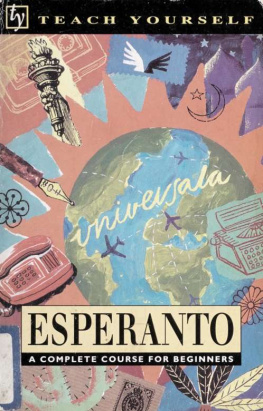Helen Fryer - The Esperanto Teacher / A Simple Course for Non-Grammarians
Here you can read online Helen Fryer - The Esperanto Teacher / A Simple Course for Non-Grammarians full text of the book (entire story) in english for free. Download pdf and epub, get meaning, cover and reviews about this ebook. year: 2005, genre: Detective and thriller. Description of the work, (preface) as well as reviews are available. Best literature library LitArk.com created for fans of good reading and offers a wide selection of genres:
Romance novel
Science fiction
Adventure
Detective
Science
History
Home and family
Prose
Art
Politics
Computer
Non-fiction
Religion
Business
Children
Humor
Choose a favorite category and find really read worthwhile books. Enjoy immersion in the world of imagination, feel the emotions of the characters or learn something new for yourself, make an fascinating discovery.

- Book:The Esperanto Teacher / A Simple Course for Non-Grammarians
- Author:
- Genre:
- Year:2005
- Rating:3 / 5
- Favourites:Add to favourites
- Your mark:
- 60
- 1
- 2
- 3
- 4
- 5
The Esperanto Teacher / A Simple Course for Non-Grammarians: summary, description and annotation
We offer to read an annotation, description, summary or preface (depends on what the author of the book "The Esperanto Teacher / A Simple Course for Non-Grammarians" wrote himself). If you haven't found the necessary information about the book — write in the comments, we will try to find it.
Helen Fryer: author's other books
Who wrote The Esperanto Teacher / A Simple Course for Non-Grammarians? Find out the surname, the name of the author of the book and a list of all author's works by series.
The Esperanto Teacher / A Simple Course for Non-Grammarians — read online for free the complete book (whole text) full work
Below is the text of the book, divided by pages. System saving the place of the last page read, allows you to conveniently read the book "The Esperanto Teacher / A Simple Course for Non-Grammarians" online for free, without having to search again every time where you left off. Put a bookmark, and you can go to the page where you finished reading at any time.
Font size:
Interval:
Bookmark:

Helen Fryer.
(B.E.A. PUBLICATIONS FUNDN o . 3).
propaganda of Esperanto.
BRITISH ESPERANTO ASSOCIATION ( Incorporated ),
17, Hart Street, W.C.i.
Produced by David Starner, Tiffany Vergon, William Pattersonand the Online Distributed Proofreading Team

Perhaps to no one is Esperanto of more service than to the non-grammarian. It gives him for a minimum expenditure of time and money a valuable insight into the principles of grammar and the meaning of words, while enabling him, after only a few months of study, to get into communication with his fellow men in all parts of the world.
To place these advantages within easy reach of all is the aim of this little book. Written by an experienced teacher, revised by Mr. E. A. Millidge, and based on the exercises of Dr. Zamenhof himself, it merits the fullest confidence of the student, and may be heartily commended to all into whose hands it may come.
W. W. Padfield.

This little book has been prepared in the hope of helping those who, having forgotten the lessons in grammar which they received at school, find some difficulty in learning Esperanto from the existing textbooks. It is hoped it will be found useful not only for solitary students, but also for class work.
The exercises are taken chiefly from the "Ekzercaro" of Dr. Zamenhof. The compiler also acknowledges her indebtedness especially to the "Standard Course of Esperanto," by Mr. G. W. Bullen, and to the "Esperanto Grammar and Commentary," by Major-General Geo. Cox, and while accepting the whole responsibility for all inaccuracies and crudenesses, she desires to thank all who have helped in the preparation, and foremost among them Mr. W. W. Padfield, of Ipswich, for advice and encouragement throughout the work, and to Mr. E. A. Millidge, for his unfailing kindness and invaluable counsel and help in its preparation and revision.

The student is strongly advised to cultivate the habit of thinking in Esperanto from the very beginning of the study. To do this he should try to realise the idea mentally without putting it into English words, e.g., when learning the word "rozo" or "kolombo," let him bring the object itself before his mind's eye, instead of repeating "rozo, rose; kolombo, pigeon"; or with the sentence "la suno brilas, the sun shines," let him picture the sun shining. Having studied the lesson and learned the vocabulary, he should read the exercise, repeating each sentence aloud until he has become familiar with it and can pronounce it freely. Then turning to the English translation at the end of the book, he should write the exercise into Esperanto, compare it with the original, and re-learn and re-write if necessary. Although this method may require a little more time and trouble at first, the greater facility gained in speaking the language will well repay the outlay.
After mastering this book the student should take some reader, such as "Unua Legolibro," by Dr. Kabe, and then proceed to the "Fundamenta Krestomatio," the standard work on Esperanto, by Dr. Zamenhof.
A very good Esperanto-English vocabulary is to be found in the "Esperanto Key," d., or in "The Whole of Esperanto for a Penny."

A few words as to the origin of Esperanto will perhaps not be out of place here. The author of the language, Dr. Ludovic Zamenhof, a Polish Jew, was born on December 3rd, 1859, at Bielovstok, in Poland, a town whose inhabitants are of four distinct races, Poles, Russians, Germans, and Jews, each with their own language and customs, and often at open enmity with each other. Taught at home that all men are brethren, Zamenhof found everywhere around him outside the denial of this teaching, and even as a child came to the conclusion that the races hated, because they could not understand, each other. Feeling keenly, too, the disabilities under which his people specially laboured, being cut off by their language from the people among whom they lived, while too proud to learn the language of their persecutors, he set himself to invent a language which should be neutral and therefore not require any sacrifice of pride on the part of any race.
Interesting as is the story of Zamenhof's attempts and difficulties, it must suffice here to say that at the end of 1878 the new language was sufficiently advanced for him to impart it to schoolfellows like-minded with himself, and on December 17th of that year they fted its birth, and sang a hymn in the new language, celebrating the reign of unity and peace which should be brought about by its means, "All mankind must be united in one family." But the enthusiasm of its first followers died down under the derision they encountered, and for nine years more Zamenhof worked in secret at his language, translating, composing, writing original articles, improving, polishing, till in 1887 he published his first book under the title of "An International Language by Dr. Esperanto." (Esperanto means one who hopes).
That the idea which impelled the young Zamenhof to undertake such a work is still the mainspring of his devotion to the cause is shown by the following extract from his opening speech at the second International Esperanto Congress in 1906:"We are all conscious that it is not the thought of its practical utility which inspires us to work for Esperanto, but only the thought of the important and holy idea which underlies an international language. This idea, you all know, is that of brotherhood and justice among all peoples." And, again, in his presidential address at the third Esperanto Congress, held this year (1907) at Cambridge, he said, "We are constantly repeating that we do not wish to interfere in the internal life of the nations, but only to build a bridge between the peoples. The ideal aim of Esperantists, never until now exactly formulated, but always clearly felt, is: To establish a neutral foundation, on which the various races of mankind may hold peaceful, brotherly intercourse, without intruding on each other their racial differences."
Sur netrala lingva fundamento,
Komprenante unu la alian,
La popoloj faros en konsento
Unu grandan rondon familian.
(On the foundation of a neutral language,
Understanding one another,
The peoples will form in agreement
One great family circle).
Helen Fryer.
December, 1907.

In Esperanto each letter has only one sound, and each sound is represented in only one way. The words are pronounced exactly as spelt, every letter being sounded.
Font size:
Interval:
Bookmark:
Similar books «The Esperanto Teacher / A Simple Course for Non-Grammarians»
Look at similar books to The Esperanto Teacher / A Simple Course for Non-Grammarians. We have selected literature similar in name and meaning in the hope of providing readers with more options to find new, interesting, not yet read works.
Discussion, reviews of the book The Esperanto Teacher / A Simple Course for Non-Grammarians and just readers' own opinions. Leave your comments, write what you think about the work, its meaning or the main characters. Specify what exactly you liked and what you didn't like, and why you think so.





